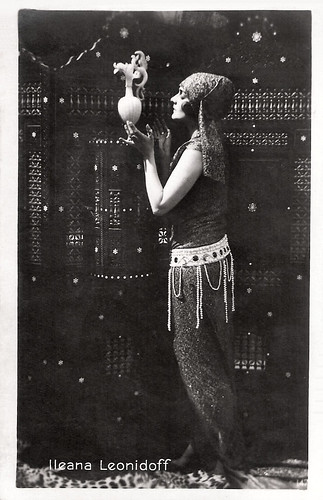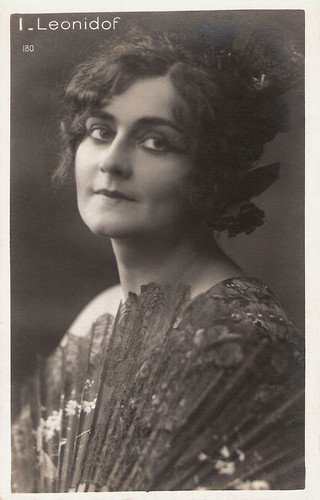Russian dancer, choreographer, and actress Ileana Leonidoff or Helena Leonidof (1893-?) had a rather short but quite prolific film career in the Italian silent cinema in the late 1910s. Her film debut was the futurist classic Thais (1917). Later 'la Divina Ileana' became an important choreographer, first in Italy and later in South America.

Italian postcard by Ed. A. Traldi, Milano, no. 509.

Vintage Italian postcard.

Italian postcard, no. 218. Photo: Bettini, Roma.
Ileana Leonidoff was born Elena Sergeevna Pisarevskaja in Sevastopol, Russian Empire in 1893.
She started her career as a dancer and was the inventor of the 'Russian Dance Leonidoff'.
She made her film debut in the legendary futurist film Thais (Anton Giulio Bragaglia, 1917). Three-quarters of this film is a classic diva drama about a man-devouring woman, played by Thais Galitzky.
In the film, Thais causes a noble friend and rival in love (Leonidoff) to commit suicide by racing with her horse towards an abyss. Thais repents and kills herself by mortal vapours, in the only scene where we really see futurist settings, designed by Enrico Prampolini.
Curiously enough, in the film, Leonidoff's character was named Bianca Stagno-Bellincioni, the name of a real and known actress. Maybe because the real Stagno-Belllincioni was the Italian interpreter of Massenet's 'Thais'.

Italian postcard by Ed. Vettori, Bologna, no. 147. Photo: publicity still for one of Leonidoff's costume films.

Italian promotonal card. Photo: Vera Film. Ileana Leonidoff and Mario Cusmich in Saffo (Aldo Molinari, 1918). The backside of the card promotes the premiere of the film in Rome in 1921 (so three years after its making).

Italian card for the film Saffo (Aldo Molinari, Vera Film 1918, released 1921), starring Ileana Leonidoff and Mario Cusmich. Publicity for its Roman premiere at the Teatro IV Fontane and Cinema Regina in Rome, on Friday 25 March 1921. The card promotes the film as containing a grandiose mise-en-scene, over 3000 extras, Olympic Games, Greek-Roman wrestling, chariot races, discus throwing, etc.
Ileana Leonidoff had leads in several period pieces directed by Aldo Molinari for the Vera Film Company and almost always opposite Guido Guiducci. The first of these was Saffo (1918), where Leonidoff played the title role, followed by Maria di Magdala (1918), Venere/Venus (1919), Il mistero di Osiris/The Mystery of Osiris (1919), and Giuditta e Oloferne/Judith and Holofernes(1920).
She also performed in films by renowned directors such as Augusto Genina (Il siluramento dell'Oceania/The torpedoing of Oceania, 1917), Leopoldo Carlucci (La flotta degli emigranti/The Fleet of Migrants, 1917), Febo Mari (Attila, 1918), Eleuterio Rodolfi (Il mistero della casa di fronte/The Mystery of the House Across, 1919) and Ugo Falena (Giuliano l'Apostata/Julian the Apostate, 1919; Il volo degli aironi/The Flight of Herons, 1920).
She had a minor part as Tamah in La sacra Bibbia/The Bible (Pier Antonio Gariazzo, 1920) with Bruto Castellani, a film in which her co-partner Guiducci played Moses. The costumes for this film were by the well-known Caramba (Luigi Sapelli). The film was shown worldwide, in the US too (in 1922, under the title After Six Days).
After one more film by Molinari, Il principe di Kaytan (1922), Leonidoff withdrew from the cinema. She went back to dancing. Together with Dimitri Rostaff , she was the first director of the newly founded dance school of the Teatro Reale dell'Opera of Rome in 1928. She remained active in Italy as a choreographer in the 1930s. On the eve of World War II, she emigrated to South America. In 1951 she was the first director of the newly founded Ballet Oficial de Bolivia. In the mid-1950s she was also highly active in Guayaquil, Ecuador, at the Casa de la Cultura del Guayas. They still have a Sala Ileana Leonidoff there, which opened in 1991.
In 2009, the biography 'Ileana Leonidoff: lo schermo e la danza' (Ileana Leonidoff: The Screen and the Dance) written by Laura Piccolo was published. Ileana Leonidoff passed away in 1968 in Lima, Peru. She was 74.

Italian postcard by G. Vettori, Bologna, no. 180.

Italian postcard by Fotocelere.

Italian postcard by Fotocelere, Turin.
Sources: Vittorio Martinelli (Il cinema muto italiano, 1917/1918/1919/1920), Italian Gerry and IMDb.
This post was last updated on 17 March 2025.

Italian postcard by Ed. A. Traldi, Milano, no. 509.

Vintage Italian postcard.

Italian postcard, no. 218. Photo: Bettini, Roma.
Futurist film
Ileana Leonidoff was born Elena Sergeevna Pisarevskaja in Sevastopol, Russian Empire in 1893.
She started her career as a dancer and was the inventor of the 'Russian Dance Leonidoff'.
She made her film debut in the legendary futurist film Thais (Anton Giulio Bragaglia, 1917). Three-quarters of this film is a classic diva drama about a man-devouring woman, played by Thais Galitzky.
In the film, Thais causes a noble friend and rival in love (Leonidoff) to commit suicide by racing with her horse towards an abyss. Thais repents and kills herself by mortal vapours, in the only scene where we really see futurist settings, designed by Enrico Prampolini.
Curiously enough, in the film, Leonidoff's character was named Bianca Stagno-Bellincioni, the name of a real and known actress. Maybe because the real Stagno-Belllincioni was the Italian interpreter of Massenet's 'Thais'.

Italian postcard by Ed. Vettori, Bologna, no. 147. Photo: publicity still for one of Leonidoff's costume films.

Italian promotonal card. Photo: Vera Film. Ileana Leonidoff and Mario Cusmich in Saffo (Aldo Molinari, 1918). The backside of the card promotes the premiere of the film in Rome in 1921 (so three years after its making).

Italian card for the film Saffo (Aldo Molinari, Vera Film 1918, released 1921), starring Ileana Leonidoff and Mario Cusmich. Publicity for its Roman premiere at the Teatro IV Fontane and Cinema Regina in Rome, on Friday 25 March 1921. The card promotes the film as containing a grandiose mise-en-scene, over 3000 extras, Olympic Games, Greek-Roman wrestling, chariot races, discus throwing, etc.
Period pieces
Ileana Leonidoff had leads in several period pieces directed by Aldo Molinari for the Vera Film Company and almost always opposite Guido Guiducci. The first of these was Saffo (1918), where Leonidoff played the title role, followed by Maria di Magdala (1918), Venere/Venus (1919), Il mistero di Osiris/The Mystery of Osiris (1919), and Giuditta e Oloferne/Judith and Holofernes(1920).
She also performed in films by renowned directors such as Augusto Genina (Il siluramento dell'Oceania/The torpedoing of Oceania, 1917), Leopoldo Carlucci (La flotta degli emigranti/The Fleet of Migrants, 1917), Febo Mari (Attila, 1918), Eleuterio Rodolfi (Il mistero della casa di fronte/The Mystery of the House Across, 1919) and Ugo Falena (Giuliano l'Apostata/Julian the Apostate, 1919; Il volo degli aironi/The Flight of Herons, 1920).
She had a minor part as Tamah in La sacra Bibbia/The Bible (Pier Antonio Gariazzo, 1920) with Bruto Castellani, a film in which her co-partner Guiducci played Moses. The costumes for this film were by the well-known Caramba (Luigi Sapelli). The film was shown worldwide, in the US too (in 1922, under the title After Six Days).
After one more film by Molinari, Il principe di Kaytan (1922), Leonidoff withdrew from the cinema. She went back to dancing. Together with Dimitri Rostaff , she was the first director of the newly founded dance school of the Teatro Reale dell'Opera of Rome in 1928. She remained active in Italy as a choreographer in the 1930s. On the eve of World War II, she emigrated to South America. In 1951 she was the first director of the newly founded Ballet Oficial de Bolivia. In the mid-1950s she was also highly active in Guayaquil, Ecuador, at the Casa de la Cultura del Guayas. They still have a Sala Ileana Leonidoff there, which opened in 1991.
In 2009, the biography 'Ileana Leonidoff: lo schermo e la danza' (Ileana Leonidoff: The Screen and the Dance) written by Laura Piccolo was published. Ileana Leonidoff passed away in 1968 in Lima, Peru. She was 74.

Italian postcard by G. Vettori, Bologna, no. 180.

Italian postcard by Fotocelere.

Italian postcard by Fotocelere, Turin.
Sources: Vittorio Martinelli (Il cinema muto italiano, 1917/1918/1919/1920), Italian Gerry and IMDb.
This post was last updated on 17 March 2025.
4 comments:
Hello, what strange serendipity! I just came across her last night, and posted it in my own blog : http://ghoulnextdoor.tumblr.com/post/480672351/ileana-leonidoff-via-russi-in-italia-from-the
Incidentally...maybe you can help me. I am going crazy trying to figure out who this is. Do you know?
http://ghoulnextdoor.tumblr.com/post/476846433/ghoulnextdoor-says-what-a-fantastic-headddress
Thank you!
Thanks for stopping by.
Jan (of Truus, Bob & Jan Too!) is the specialist on Italian divas. He told me that the only diva who ever showed her naked breasts on screen was Rina De Liguoro.But the woman of your picture looks more like Theda Bara, who was a vamp but never appeared in the nude. Another guess is an extra of a Cecil B. De Mille extravaganza. He sure loved weird costumes like in his Madam Satan (1930). But this still seems to be from a film, made 15 years earlier. The Devil Stone?
Greetings from Amsterdam
Thanks, Bob and Jan! I did check out the divas you mentioned, and sadly still cannot find the woman in question...but I have learned a lot in the meantime. I appreciate your suggestions and you can bet I will let you know the identity should I ever find out!
Hi ,
I'm confused. I checked across this post while researching something and was wondering whom exactly you are trying to identify.
John Alegria
Post a Comment